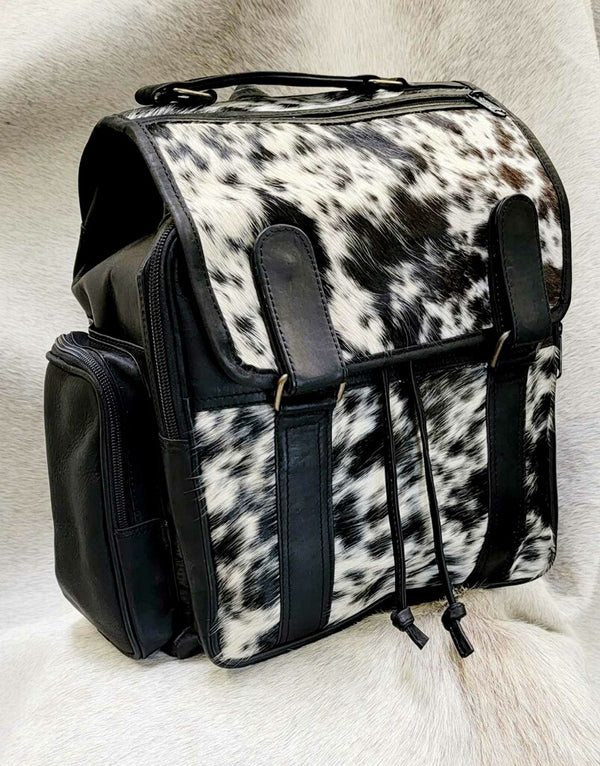In a world where fashion trends come and go, there is something timeless and enduring about a genuine cowhide bag. These versatile accessories have stood the test of time, living through the many fashion seasons and remaining popular year after year. One of the secrets to their remarkable popularity lies in the longevity, durability, and resilience of the material they are made from. Here, we will take you through the fascinating journey of cowhide production, the crafting of cowhide bags, and how to maintain the quality of these bags for years to come.
From Raw Leather to Cowhide
Step 1: Sourcing Raw Leather
The journey of transforming raw leather into hides begins with the selection of suitable raw leather materials. Typically, these raw materials come from the hides of animals, with cowhide being one of the most common sources. The hides are obtained from abattoirs and tanneries, where they are a byproduct of the meat industry.
Step 2: Preparing the Hides
Once the hides are sourced, they undergo an initial preparation process to remove any flesh, fat, and hair from the surface. This is typically done through a process called "fleshing," which uses specialized tools to scrape away unwanted materials.
Step 3: Curing and Preservation
After fleshing, the hides are preserved to prevent decay. One common method is salt-curing, where the hides are treated with salt to remove moisture and inhibit bacterial growth. The salted hides are then stacked and left to cure for several days.
Step 4: Soaking and Rehydration
To prepare the hides for tanning, they are soaked in water to rehydrate them. Soaking softens the hides and readies them for the tanning process. The duration of soaking can vary but typically takes several hours to a day, depending on the thickness of the hides.
Step 5: Liming
Following soaking, the hides go through a process known as liming. During liming, the hides are treated with a mixture of lime and water. This serves to swell the collagen fibers, loosen hair, and remove any remaining flesh and epidermis. Liming also adjusts the pH of the hides, making them more receptive to tanning agents.
Step 6: Deliming and Bating
After liming, the hides are delimed to neutralize the excess lime and then undergo a process called bating. Bating further softens the hides and eliminates any residual non-fibrous proteins, ensuring they are ready for tanning.
Step 7: Tanning
Tanning is the central step in transforming raw leather into hides. During tanning, chemical agents or natural substances known as tannins are used to stabilize the collagen fibers in the hides. Tannins can be derived from vegetable sources (vegetable tanning) or synthetic chemicals (chrome tanning). The choice of tanning method depends on the desired characteristics of the final product. Tanning can take several weeks and is crucial in making the leather resistant to decay, durable, and flexible.
Step 8: Neutralization
After the tanning process, the hides are neutralized to balance the pH levels. This helps remove any residual tanning agents and prevents further chemical reactions.
Step 9: Dyeing and Finishing
To impart color and enhance the visual appeal of the hides, they are dyed during this step. Finishing processes, like waxing or oiling, are also carried out to give the hides a smooth texture and a glossy sheen. These steps contribute to the final aesthetics of the hides.
Step 10: Grading and Sorting
The hides are then graded and sorted based on their quality. Hides are inspected for imperfections, thickness, and overall appearance. Full-grain hides, which are of the highest quality and feature natural grain, are often used for premium leather products.
Step 11: Quality Control
Before the hides are sent to manufacturers, they undergo quality control inspections. This ensures that only the best hides are used for crafting high-quality leather goods.
Crafting Cowhide Bags

Step 1: Selection of High-Quality Cowhide
The journey begins with the careful selection of high-quality cowhide. The hides are sourced from tanneries and undergo a rigorous quality control process. Factors like thickness, grain, and imperfections are considered during this stage.
Step 2: Cutting and Shaping
Once a suitable cowhide is selected, the design of the bags is laid out on the hide. Skilled artisans create patterns that maximize the use of the leather while preserving its unique characteristics. Each piece required for the bag is then meticulously cut from the cowhide.
Step 3: Preparing the Leather
The cut pieces are prepared for bag construction. They are trimmed, edges are smoothed, and any necessary adjustments are made to ensure uniformity in the final product. This preparation step is essential to achieve clean lines and a polished appearance.
Step 4: Stitching
Sewing is a critical step in crafting cowhide bags. Skilled craftsmen use strong, durable threads, often matching the color of the leather, to stitch the pieces together. The stitching pattern is carefully executed to ensure strength and structural integrity.
Step 5: Assembly
The pieces are assembled together, often involving the attachment of handles, straps, and other structural elements. The careful alignment and joining of components are vital to the bag's shape, functionality, and longevity.
Step 6: Hardware and Accents
High-quality cowhide bags are often adorned with premium hardware, including zippers, clasps, buckles, and rivets. The choice of these accessories is essential, both for functional purposes and to enhance the bag's overall aesthetics.
Step 7: Lining and Interior Features
Interior lining is added to the bags for both aesthetic and practical purposes. The lining protects the interior and provides additional pockets or compartments for organizing belongings. The choice of lining material is crucial to ensure durability and quality.
Step 8: Finishing Touches
Finishing touches are added to the bags to enhance their appearance and quality. This may include edge painting, embossing, or stamping of the brand logo or other decorative elements. Edge painting reinforces the bag's edges and adds to its aesthetic appeal.
Maintaining the Quality of Cowhide Bags

Handbags are not just accessories; they are investments in style and functionality. To ensure your handbag remains in pristine condition and continues to complement your look for years to come, proper maintenance is essential.
1. Regular Cleaning
Dust and dirt can accumulate on your handbag's surface, leading to premature wear and tear. To prevent this, regularly wipe your handbag with a soft, dry cloth. For leather handbags, consider using a damp cloth for deeper cleaning. Be sure to check the manufacturer's care instructions, as different materials may require specific cleaning methods.
2. Protect from Moisture
Moisture can be a handbag's worst enemy. Rain, spills, and even high humidity can damage your handbag, especially if it's made of leather or fabric. Always carry an umbrella and use a waterproof spray or protectant to shield your handbag from unexpected downpours. If your handbag does get wet, stuff it with tissue paper and allow it to air dry at room temperature to maintain its shape and avoid mildew.
3. Avoid Direct Sunlight
Prolonged exposure to direct sunlight can cause colors to fade and materials to weaken. When not using your handbag, store it in a cool, dry place away from direct sunlight. Consider using a dust bag to protect it from light exposure and dust.
4. Be Mindful of Where You Place It
Avoid placing your handbag on rough or dirty surfaces. Hang it on a purse hook or place it on a clean, flat surface to prevent scratches and stains. Additionally, don't place it on the floor, as floors can be dirty and harbor bacteria.
5. Handle with Clean Hands
Always handle your handbag with clean hands. Oils, lotions, and dirt from your hands can transfer to the bag, potentially causing stains or discoloration. If you have just applied lotion or perfume, allow it to absorb completely before handling your handbag.
6. Rotate Your Collection
If you have a collection of handbags, it's a good idea to rotate them regularly. This gives each bag a chance to "rest" and prevents overuse of one particular handbag. By doing this, you'll extend the lifespan of all your bags.
7. Storage Matters
When not in use, store your handbags properly. Stuff them with tissue paper or bubble wrap to maintain their shape and structure. Keep them in a dust bag, and consider using a shelf, a closet organizer, or a dedicated handbag storage solution to prevent dust and accidental damage.
8. Handle Repairs Promptly
If you notice any loose threads, missing hardware, or minor damage to your handbag, address it promptly. Delaying repairs can lead to more extensive damage that may be costlier to fix.
Final Thoughts
The surprising durability of cowhide bags can be attributed to the meticulous process of transforming raw leather into exquisite cowhide and the craftsmanship that goes into designing and crafting these timeless accessories. If you, too, desire to invest in these quality pieces, feel free to reach out to us at Cowhide Gallery. Our team of skilled craftsmen work tirelessly to design unique, genuine cowhide bags that last for generations to come. Contact us today to begin browsing our collection.


